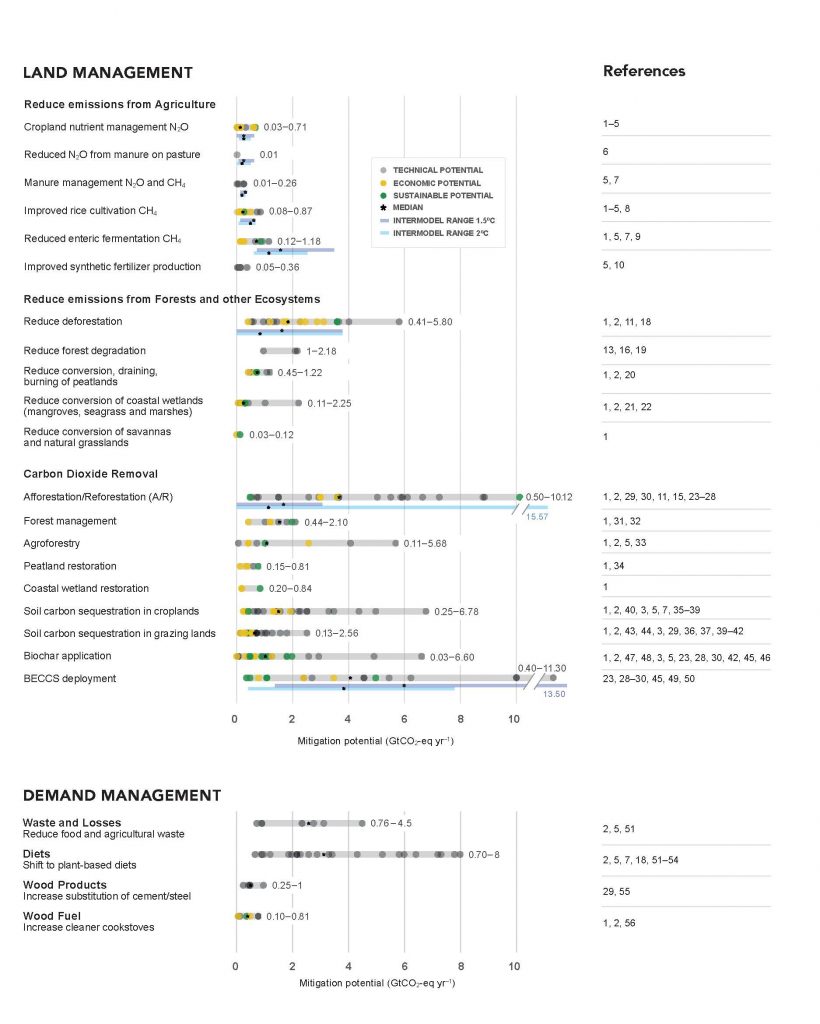
Figure 2.24
Mitigation potential of response options in 2020–2050, measured in GtCO2-eq yr–1, adapted from Roe et al. (2017).Mitigation potentials reflect the full range of low to high estimates from studies published after 2010, differentiated according to technical (possible with current technologies), economic (possible given economic constraints) and sustainable potential (technical or economic potential constrained by sustainability considerations). Medians are calculated across all potentials in categories with more than four data points. We only include references that explicitly provide mitigation potential estimates in CO2-eq yr–1(or a similar derivative) by 2050. Not all options for land management potentials are additive, as some may compete for land. Estimates reflect a range of methodologies (including definitions, global warming potentials and time horizons) that may not be directly comparable or additive. Results from IAMs are shown to compare with single option ‘bottom-up’ estimates, in available categories from the 2ºC and 1.5ºC scenarios in the SSP Database (version 2.0). The models reflect land management changes, yet in some instances, can also reflect demand-side effects from carbon prices, so may not be defined exclusively as ‘supply-side’. References: 1) Griscom et al. (2017), 2) Hawken (2017), 3) Paustian et al. (2016), 4) Beach et al. (2016), 5) Dickie et al. (2014), 6) Herrero et al. (2013), 7) Herrero et al. (2016), 8) Hussain et al. (2015), 9) Hristov, et al. (2013), 10) Zhang et al. (2013), 11) Houghton and Nassikas (2018), 12) Busch and Engelmann (2017), 13) Baccini et al. (2017), 14) Zarin et al. (2016), 15) Houghton, et al. (2015), 16) Federici et al. (2015), 17) Carter et al. (2015), 18) Smith et al. (2013), 19) Pearson et al. (2017), 20) Hooijer et al. (2010), 21) Howard (2017), 22) Pendleton et al. (2012), 23) Fuss et al. (2018), 24) Dooley and Kartha (2018), 25) Kreidenweis et al. (2016), 26) Yan et al. (2017), 27) Sonntag et al. (2016), 28) Lenton (2014), 29) McLaren (2012), 30) Lenton (2010), 31) Sasaki et al. (2016), 32) Sasaki et al. (2012), 33) Zomer et al. (2016), 34) Couwenberg et al. (2010), 35) Conant et al. (2017), 36) Sanderman et al. (2017), 37) Frank et al. (2017), 38) Henderson et al. (2015), 39) Sommer and Bossio (2014), 40. Lal (2010), 41. Zomer et al. (2017), 42. Smith et al. (2016), 43) Poeplau and Don (2015), 44. Powlson et al. (2014), 45. Powell and Lenton (2012), 46) Woolf et al. (2010), 47) Roberts et al. (2010), 48. Pratt and Moran (2010), 49. Turner et al. (2018), 50) Koornneef et al. (2012), 51) Bajželj et al. (2014), 52) Springmann et al. (2016), 53) Tilman and Clark (2014), 54) Hedenus et al. (2014), 55) Miner (2010), 56) Bailis et al. (2015).